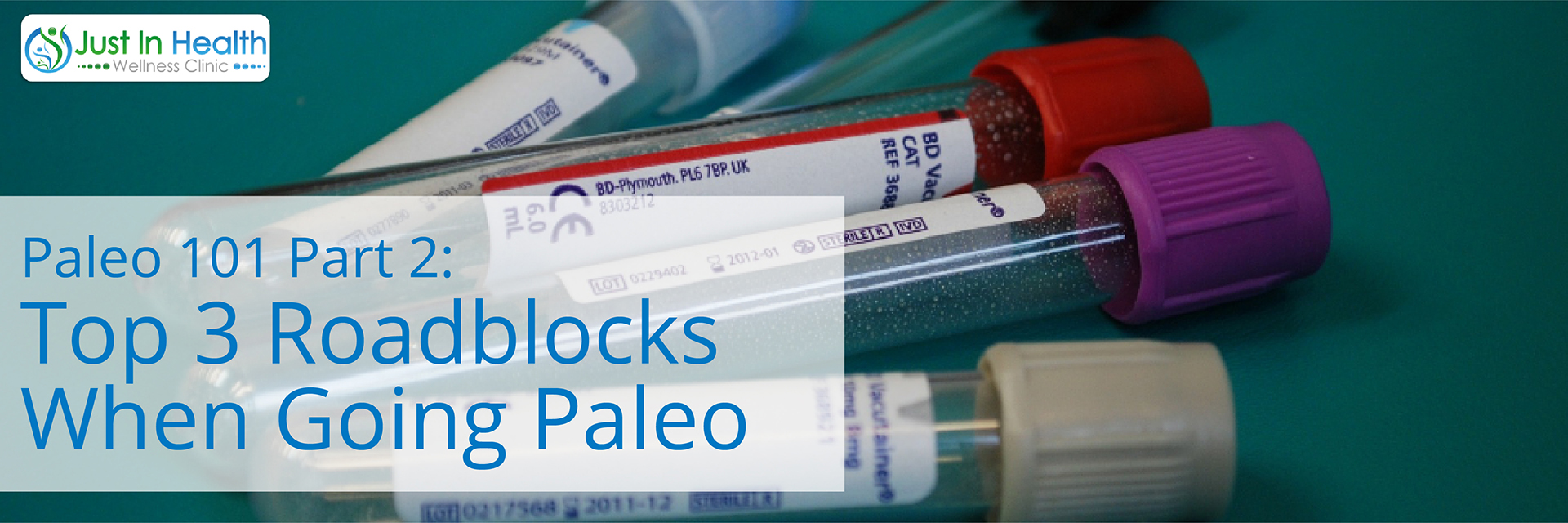
 By Dr. Justin Marchegiani
By Dr. Justin Marchegiani
Welcome to Part 2 of our Paleo Diet series, where we are looking at lab markers to help you transition successfully to a healthy diet and the roadblocks that can get in your way. In part 1 of our Paleo Diet series. We discussed inflammation, blood sugar, and lipid lab markers and what to look for on these tests as you begin a Paleo diet, or template. Briefly, we want to see your lipids improve, whether it’s triglyceride to HDL ratio of cholesterol to HDL ratio, and we want to see improvement in inflammation and blood sugar. These would be the nice benefits of an anti-inflammatory, nutrient-dense, low-toxin eating plan.
So let's say you’re one to two months in, and you’re seeing some improvement. It’s going well, and you’re on the right track; but now, you’re hitting some roadblocks. Maybe you’re fatigued or have energy issues, your fingernail quality doesn’t look good, you still have some digestive issues (bloating, gas, constipation, or diarrhea). And maybe they have gotten even worse since you you’ve increased your protein content.
Anti-inflammatory, nutrient‑dense, low-toxin food should not make you feel worse unless your digestive system is impaired in some way or another. So now, it’s time to dig in a bit deeper and get those roadblocks out of the way.
The three main roadblocks we’re going to address are anemia, infections, and thyroid issues. We’ll also cover the lab markers we would look at when considering each.

In people whose hydrochloric acid (HCl, stomach acid) levels are low, anemia can be an issue. Interestingly, this happens in people who eat a lot of easy-to-digest food. Because of anemia, their stomach acid and their digestive secretions weaken because they aren't staying tuned up with the proper proteins.
This is seen in people who have a strictly vegetarian or vegan diet. There may even be some gastrointestinal inflammation preventing us from binding minerals. And the low HCL may be preventing us from ionizing so the minerals, such as iron, calcium, selenium and magnesium can get into our bloodstream.
When we see anemia issues, the first pattern we’ll look for is a decrease in red blood cells, hematocrit, and hemoglobin. It may not necessarily be low, but it may just be in that bottom 20% of the range. This will tell us if there’s a broad-spectrum anemia.
The next anemia pattern we’ll look for is through the iron panel. TIBC and UIBC are different iron-binding proteins, and they actually tend to go high when iron is low. So the more binding proteins we have, the more iron our body needs. We will also typically see iron saturation and ferritin levels drop. If we see these markers in our anemia patterns, then we know we probably have an iron-based anemia.
We’ll also look for anemia patterns through B vitamin markers. We’ll look at MCHC, MCV, and MCH. These markers just tell us how big the red blood cells/hemoglobin are. The bigger our red blood cells are, the more immature they are. Red blood cells get smaller as they mature. So this will be an indicator of two kinds of anemia—B vitamin and iron.

A chronic infection, such as a parasite infection, bacterial infection, viral infection, or even a fungal infection, may be present. These infections will affect our immune system. About 70–80% of our immune system lives in the gastric associated lymphoid tissue (GALT) of our stomach and in the mucosal associated lymphoid tissue (MALT) of our intestinal tract. So with so much of our immune system living in our stomach and intestinal tract, it’s clear to see why an infection could be affecting our ability to properly absorb nutrients.
When we have digestive immune stress, it fires the sympathetic nervous system (i.e., our fight-or-flight system). We have two branches to our nervous system. Our sympathetic nervous system is our flight-or-flight nervous system, and our parasympathetic nervous system is our rest-and-digest system.
When our sympathetic nervous system is fired up, it’s going to drive more of our fight-or-flight response. It will decrease hydrochloric acid and enzymes, and it will increase blood flow to the extremities—arms, hands, and feet—to allow us to fight and flee. This is one of the major issues when we’re under chronic stress, and those stressors could come from infections.
One lab test we would look at for infections would be a stool panel, and not just the conventional hospital or Lab Corps tests—I run many of those and they sometimes miss the infection. We would run a specialty test, especially the DNA, PCR-based testing. We have a higher level of sensitivity and specificity on them. Also, we can draw conclusions from a CBC with differential panel. This looks at our white blood cells—our neutrophils, lymphocytes, monocytes, eosinophils, and basophils (an easy way to remember these: Never Let Monkeys Eat Bananas). We might consider the following based on an increase in these cells:

Next we have thyroid issues. Cold hands, cold feet, constipation, mood issues, and energy issues are all signs the thyroid is not functioning appropriately. So we’ll want to run a complete thyroid panel.
We typically run our TSH, which is a brain hormone. This gives us a peek inside the window to what's happening with our brain and how it’s communicating with our thyroid. We’ll also look at thyroid hormones: free T4 and T3, total T4 and T3. T4 tells us what is coming out of the thyroid tissue, and T3 gets converted by the liver and intestines, by healthy stress levels, and at the thyroid (about 20% gets converted at the thyroid).
We’ll also run our antibodies, too, which are basically looking at our immune system. Our immune system could actually be attacking our thyroid gland and making various antibodies called TPO, TB antibodies, thyro-binding globulin antibodies, and even TSH receptor site antibodies. This would tell us if we are dealing with an autoimmune thyroid condition, such as Hashimoto’s thyroiditis.
It takes time when transitioning to an anti-inflammatory, nutrient-dense, low-toxin diet. The Paleo template will get you on the right road, but you will likely encounter a few roadblocks along the way. Don’t let them dissuade you—address them one by one, and before you know it, those roadblocks will be far behind you.